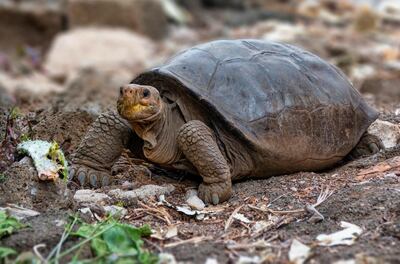Scientific work funded by an Abu Dhabi organisation showed that a species of giant tortoise from the Galapagos Islands last seen a century ago and feared to have become extinct is very much alive.
The Mohamed bin Zayed Species Conservation Fund provided a grant to support genetic analysis of a giant tortoise found on the archipelago's remote and mostly barren Fernandina Island about two years ago.

That showed that the female reptile was a Fernandina giant tortoise, a species last reported in 1906.
The fund provided two grants, totalling $30,000 (Dh110,196), towards the work at Yale University on the tortoise, named Fern, who was found during a mission by the Galapagos National Park Directorate and Galápagos Conservancy in February 2019.
Along with two other organisations, Re:wild and Turtle Conservancy, the study compared Fern's DNA with archive samples from a long-dead Fernandina.
In finding that it matched, researchers eliminated the possibility that the elderly female was a member of another giant tortoise species carried from a different island.
Sailors moved the tortoises between islands to create food sources.
"Giant tortoises have always been a source of wonder and awe and now, through Fern, they are again taking up their mantle as a symbol of hope for our planet's lost and endangered species, and the protection and restoration of biodiversity," said Don Church, Re:wild's president.
Hope for a breeding programme
Before Fern was discovered "on the flank of a volcano, tucked deep inside a shrub complex" there were hints that giant tortoises remained on Fernandina Island.
In 1964, a mission to the island, which is difficult to get to and is largely covered with lava, found tortoise droppings, while 12 years ago, what appeared to be a tortoise was seen from the air.
Scientists hope that more specimens of the species, which has the scientific name Chelonoidis phantasticus, can be found.
If this happens, they plan to set up a breeding programme.
The Galapagos Islands now have as few as 10 per cent of their original 300,000 population of tortoises, as their numbers were decimated by pirates and whalers, who took thousands for food, and caused further harm by introducing alien species such as rats, pigs and goats, which ate tortoise eggs or young, or damaged the habitat.
The 15 giant tortoise species are all now protected, and the Galapagos National Park Directorate has bred and released thousands of the creatures onto islands in the archipelago, which lie in the Pacific about 1,000 kilometres west of mainland Ecuador.
Several years ago, the national park reintroduced Espanola tortoises to Santa Fe Island, whose population of tortoises was wiped out about 150 years ago.
The Mohamed bin Zayed Species Conservation Fund has made 2,152 grants to conserve 1,402 species or subspecies of animals, plants and other organisms since it was launched in 2009 with an initial endowment of $25 million (Dh91.82m). Most grants do not exceed $25,000.











